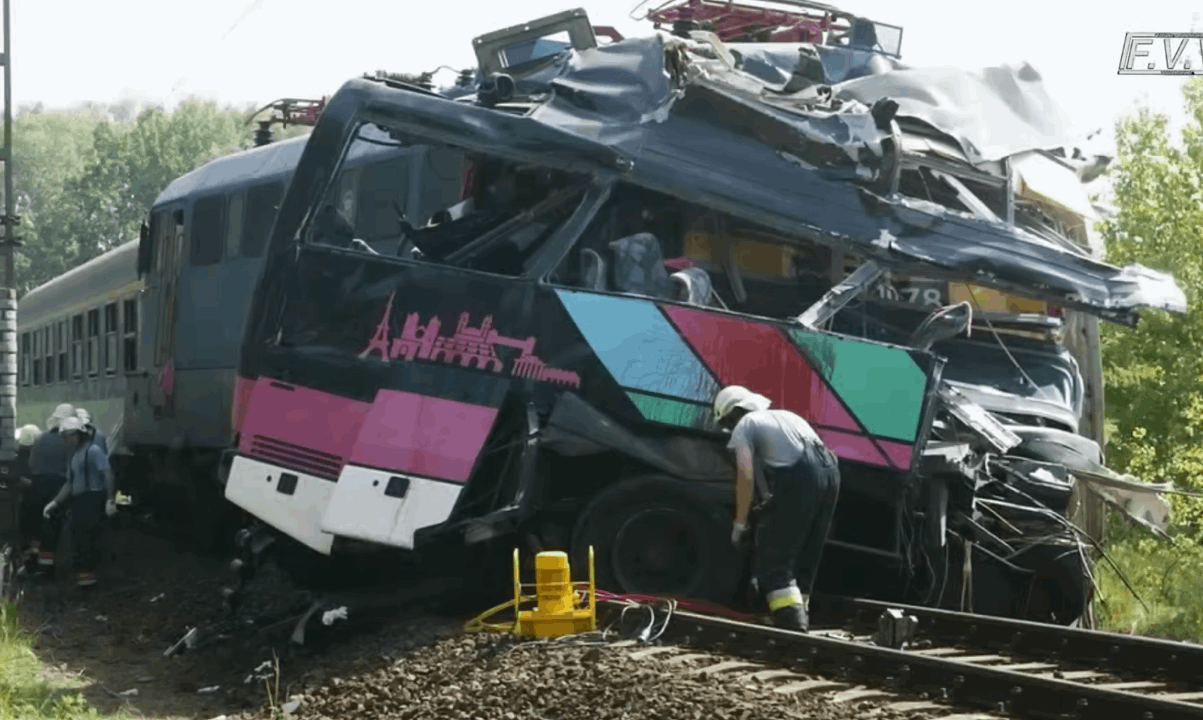VIDEO: Horrific train-bus collision claims dozens of German lives, Hungarian train conductor shares harrowing account

Massive crash, choking dust, the stench of smoke, human body parts and bus fragments scattered everywhere. Then, a deafening silence. That’s how the train engineer, who was not at fault, recalled the tragic event that occurred 22 years ago in an interview on TV2’s Napló program on Sunday. In the wake of the accident, the Hungarian government accelerated the installation of mechanical half-barriers at railway crossings, realising these offered far more protection than lights alone. But the memory of the tragedy lives on in the residents of Siófok, the victims’ families in Germany—and in the train engineer himself, who stayed away from the crash site for more than two decades.
“You’re finished, you poor soul. What did you do?”
On the morning of 8 May 2003, three German tourist buses left the Lidó Hotel, carrying vacationers—mostly retirees—who were heading to a nearby restaurant for breakfast. Just half a kilometer down the road, at the railway crossing on Darnay Kálmán Square, the signal was still white as the first bus crossed. However, by the time the second bus in the convoy arrived, it had turned red. Debate still continues over whether the driver was blinded by the sun or simply believed he could make it through. There was no barrier at the time. Either way, he pressed on.
Meanwhile, an express train under the control of engineer Ferenc Kiss was barreling toward the crossing at 100 km/h (62 mph). The train and the bus met at the crossing. Despite Kiss’ relentless horn blasts and emergency braking, there was no time to stop or avoid the collision.
The driver and the engineer locked eyes one last time. We’ll never know what the bus driver—who died on the spot—said, if anything. But Kiss recalls yelling to himself, alone in the cab, “You’re finished, you poor soul. What did you do?”
- A body was found in Lake Velence

Dozens dead, passengers stood no chance
Only five people on the bus survived, including a Hungarian tour guide. Four passengers died in transit or later at the hospital. Twenty-nine died at the scene. One victim was found only after an extensive search—in the locomotive’s engine compartment. It remains one of Hungary’s deadliest transportation disasters of the new century. Then-Prime Minister Péter Medgyessy rushed to the site, and efforts intensified to equip crossings with mechanical barriers. The light signal simply wasn’t enough.
Police interrogated the engineer after his hospital admission, but found no misconduct. Kiss had done everything he could—but reducing a train’s speed from 100 km/h to zero in such short distance was impossible. For 375 meters, the locomotive dragged half the shattered bus before finally halting.
- High-speed car chase in Budapest: WATCH the moment of arrest

Engineer recounts near-death experience
Ferenc Kiss told Napló that he never believed a person’s life could flash before their eyes during a near-death experience. “But now I know it’s true,” he said. In those seconds, crouched in the cab, inches away from getting crushed, every childhood prank came rushing back to him.
Today, a memorial plaque on the wall of a nearby church honors the lives lost. The crossing is now equipped with a barrier—but accidents still occur. In 1980, a similar incident at the same site claimed 19 lives.
Survivors left in shock
Survivors at the time were in traumatic shock. One German pensioner—who stayed behind due to high blood pressure—was later asked for a photo to help identify his girlfriend. None of the survivors have spoken publicly since, except Ferenc Kiss. No one on the train was injured; Kiss suffered only minor physical injuries. Despite that, he could sleep after the accident. The images didn’t plague him.

But he never operated a train again. Kiss now lives in Balatonberény, where he serves on the local volunteer patrol team. He frequently approaches and warns drivers who attempt to cross tracks against red signals.

Currently, Hungary has about 6,000 railway crossings. More than 1,200 of them operate with flashing light signals, and over 1,060 are also fitted with mechanical half-barriers that physically block the right-hand side of the crossing.

You can watch the full broadcast of TV2’s Napló HERE.
Visit our accident archive for more stories.
To read or share this article in Hungarian, click here: Helló Magyar







